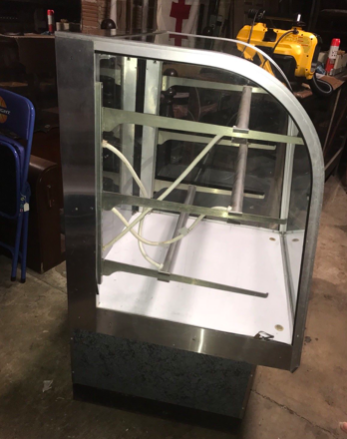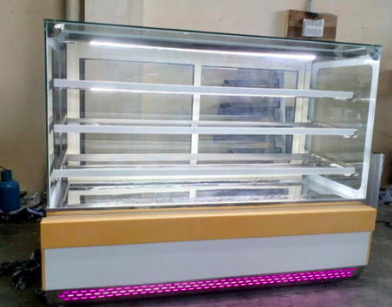Looking for cheap commercial display cases? We have a large collection of preowned inventory for sale listed directly by the owner of the equipment. These are ideal installing in a bakery, coffee shop, or restaurant that serves pastries. Browse our active listings below. Click here to view our full lineup of used restaurant equipment.
[display_listings l_type=”100″]
Introduction to Food Display Cases

You’ve been slaving for hours in your commercial kitchen, and produced some great-looking food that’s sure to sell like hotcakes. But what’s the best way to merchandise it and present it to the world? For many small businesses, including coffee shops, bakeries, convenience stores, institutional cafeterias, airport restaurants or kiosks, grocery stores, and many independent and chain restaurants, a refrigerated bakery or deli case may be just the option you’re looking for, to share your creations with your ravenous customers.
Delve into the world of purchasing a used commercial display case for just a moment, however, and you’ll quickly find that while many of these units may look similar from the outside, they offer very different options, in terms of both functionality and appearance. Let’s take a look at some of the things you should know, before you buy a used commercial display case.
What Types of Used Commercial Display Cases Are There?

Refrigerated display cases typically come in one of two different types of flavors: Forced air, and gravity coil refrigeration. Choosing the cooling technology that’s right for you and your business depends mostly on the kinds of foods you plan to display in your case.Refrigerated display cases like these use two basic types of refrigeration: Forced Air or Gravity Coil. The best type for you depends on the items you want to display in the case.
Forced air display cases use fans to move cold air throughout the display case, to keep items on display cool or cold. These types of cases are used mostly for bakery products, some types of prepackaged products, and for limited use in some deli situations. Because of the cool wind that’s always present inside the case, items that aren’t wrapped or covered, or which are left in the case for too long, have a tendency to dry out.
Refrigerated display cases which use a “gravity coil” system for keeping air cold feature a refrigeration coil at the inside top of the cabinet, which allows cool air to drop over the surface of the food inside the case. These are the types of cases most typically used for raw meat, seafood, salads, pre-packaged deli foods, or anywhere else where you need food to stay cool, without getting dried out by the circulating fans found in the forced air display cases. Gravity coil cases are usually less expensive than their forced air counterparts, as well.
What Are the Features to Look for in a Used Commercial Display Case?

Once you’ve decided between a forced air or a gravity coil display case, it’s time to start looking at the additional features that make each case unique. Among these considerations:
Size. While it can be tempting to buy as big a display case as you can fit, given the real estate in your display area, consider what you’re going to be filling the case with. If the products you plan to display move quickly or have a short shelf life, you might find you can get away with using a smaller case, which are less expensive to purchase, and less costly to run.
If space to place the commercial display case is at a premium, look for so-called “low profile” display cases. These usually boast the same features as larger cases, but built in a smaller form factor, which makes these types of cases a good fit for smaller stores or restaurants.
When possible, examine the manual or specification sheet for the used display case you are considering, to make sure that the space where you plan to install the case allows the recommended room for air intake and exhaust. And finally, please, PLEASE measure your doorways; we know a guy (and he’s the guy writing this very guide) who recently bought a large display case, only to have to spend additional money hiring a carpenter to widen all of his doorframes, to get the beast inside.
Shelving. Most display cases incorporate tiered shelving in their cabinets, to help maximize the visibility of every item in the case, no matter how full. Look for display cases with shelves that can be positioned either horizontally flat, or angled slightly toward the front of the case to help hungry customers get a better look at what you have to offer.
Glass shelving is another option in some types of cases; they allow more light to pass through the case, which always improves the visual appeal of food, offer more options for display, and are less prone to corrosion or other problems common in wire shelving.
Glass style. Most refrigerated case manufacturers offer your choice between straight glass, or curved glass displays. This option comes down entirely to personal preference; some people like the sleek, modern style of curved glass, while others embrace the industrial, retro appeal of straight glass. Try to check out both options in person, before you make the decision about which look is the best fit for your business.
Lighting. Most modern bakery and deli cases feature lighted interiors designed to flatter your products and make them look their most appetizing and appealing. Some models use special lighting designed for red meat, for example, or different colored lighting for baked goods or pastries. Check to see whether the unit you are considering has overhead-mounted lighting, or shelf-mounted lighting, to decide which will best highlight the appeal of your food.
Colors, end panels, mirrors, and other bells and whistles. End panels help to make your case appear larger and more filled with product (and a full case is a busy case). Full cases tend to make customers think of the food as fresher and more bountiful, and reflective end panels will help to keep the case looking full, even as you move through product. Mirrored rear glass doors achieve the same thing, with the added benefit of helping to hide whatever’s going on behind the case, which may be of benefit in some kitchens.
Another important option to consider is the interior color of your used commercial display case. Black interiors help hide the hardware “guts” of the case, while offering a dramatic background that allows the colors of food to pop. Check with your local health inspector before making a purchase, however; some require display case interiors to be all white, to help with cleaning, maintenance and sanitation rules.
How Can I Evaluate a Used Commercial Display Case?

Evaluating a used commercial display case is very similar to evaluating any other type of major commercial refrigeration. The most important thing to check is whether the unit is maintaining a consistent temperature of less than 40 degrees.
Check for tight seals around all edges of the doors, and look for dents or dings that may not affect the function of the unit, but can help you evaluate overall how well (or badly!) it was treated. Make sure lights (if applicable) work, and make sure that the power supply for the display case matches the type of installation required for your location.
Check for buildup of grease, dust or grime in the air vents, and listen closely to the sound of the compressor; any clanging or unusual sounds (these will be hard to miss; picture the sound of a Vitamin working its way through a handful of driveway gravel) could indicate an issue with the fan or fan housing, which could spell trouble in the future. Check for ice buildup on the coils inside the case, which may indicate a problem with the unit’s thermostat, compressor, or defrost cycles.
If the used commercial display case you are considering has a price tag that seems too good to be true, make sure to ask a lot of questions. We’ve seen online auction listings for display cases which appear cosmetically perfect, with laundry lists of cool features and then only a small mention at the end of the listing that the display case is being sold without a working compressor. While this may seem like an inexpensive way to purchase an otherwise very costly piece of equipment, be aware that purchasing a new compressor for your display case can cost hundreds (or even thousands) of dollars.
Finally, a word about cleanliness. We’d all love to be able to plunk down a few bucks for a used commercial display case, install it, and immediately invite the health inspector over for a visit, but most often, the condition of used restaurant equipment makes that impossible. Don’t be put off by mold, thin layers of grime, or mysterious spills of unknown origin. Everything on a display case can be cleaned, and buying a unit that’s less-than-showroom ready may provide you with an opportunity to negotiate a lower price.
